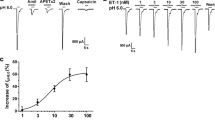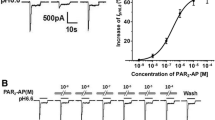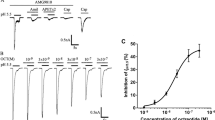Abstract
Peripheral purinergic signaling plays an important role in nociception. Increasing evidence suggests that metabotropic P2Y receptors are also involved, but little is known about the underlying mechanism. Herein, we report that selective P2Y receptor agonist uridine 5′-triphosphate (UTP) can exert an enhancing effect on the functional activity of acid-sensing ion channels (ASICs), key sensors for extracellular protons, in rat dorsal root ganglia (DRG) neurons. First, UTP dose-dependently increased the amplitude of ASIC currents. UTP also shifted the concentration–response curve for proton upwards, with a 56.6 ± 6.4 % increase of the maximal current response to proton. Second, UTP potentiation of proton-gated currents can be mimicked by adenosine 5′-triphosphate (ATP), but not by P2Y1 receptor agonist ADP. Potentiation of UTP was blocked by P2Y receptor antagonist suramin and by inhibition of intracellular G protein, phospholipase C (PLC), protein kinase C (PKC), or protein interacting with C-kinase 1 (PICK1) signaling. Third, UTP altered acidosis-evoked membrane excitability of DRG neurons and caused a significant increase in the amplitude of the depolarization and the number of spikes induced by acid stimuli. Finally, UTP dose-dependently exacerbated nociceptive responses to injection of acetic acid in rats. These results suggest that UTP enhanced ASIC-mediated currents and nociceptive responses, which reveal a novel peripheral mechanism underlying UTP-sensitive P2Y2 receptor involvement in hyperalgesia by sensitizing ASICs in primary sensory neurons.






Similar content being viewed by others
Abbreviations
- ASIC:
-
Acid-sensing ion channels
- ATP:
-
Adenosine 5′-triphosphate
- DRG:
-
Dorsal root ganglion
- IpH :
-
Proton-gated current
- PICK1:
-
Protein interacting with C-kinase 1
- PKC:
-
Protein kinase C
- PLC:
-
Phospholipase C
- TRPV1:
-
Transient receptor potential vanilloid receptor-1
- UTP:
-
Uridine 5′-triphosphate
References
Cook SP, McCleskey EW (2002) Cell damage excites nociceptors through release of cytosolic ATP. Pain 95:41–47
Lazarowski ER, Boucher RC, Harden TK (2003) Mechanisms of release of nucleotides and integration of their action as P2X- and P2Y-receptor activating molecules. Mol Pharmacol 64:785–795
Gerevich Z, Illes P (2004) P2Y receptors and pain transmission. Purinergic Signal 1:3–10
Magni G, Ceruti S (2013) P2Y purinergic receptors: new targets for analgesic and antimigraine drugs. Biochem Pharmacol 85:466–477
Kobayashi K, Fukuoka T, Yamanaka H, Dai Y, Obata K, Tokunaga A et al (2006) Neurons and glial cells differentially express P2Y receptor mRNAs in the rat dorsal root ganglion and spinal cord. J Comp Neurol 498:443–454
Molliver DC, Cook SP, Carlsten JA, Wright DE, McCleskey EW (2002) ATP and UTP excite sensory neurons and induce CREB phosphorylation through the metabotropic receptor, P2Y2. Eur J Neurosci 16:1850–1860
Moriyama T, Iida T, Kobayashi K, Higashi T, Fukuoka T, Tsumura H et al (2003) Possible involvement of P2Y2 metabotropic receptors in ATP-induced transient receptor potential vanilloid receptor 1-mediated thermal hypersensitivity. J Neurosc: Off J Soc Neurosci 23:6058–6062
Yousuf A, Klinger F, Schicker K, Boehm S (2011) Nucleotides control the excitability of sensory neurons via two P2Y receptors and a bifurcated signaling cascade. Pain 152:1899–1908
Lechner SG, Lewin GR (2009) Peripheral sensitisation of nociceptors via G-protein-dependent potentiation of mechanotransduction currents. J Physiol 587:3493–3503
Li N, Lu ZY, Yu LH, Burnstock G, Deng XM, Ma B (2014) Inhibition of G protein-coupled P2Y2 receptor induced analgesia in a rat model of trigeminal neuropathic pain. Mol Pain 10:21
Malin SA, Davis BM, Koerber HR, Reynolds IJ, Albers KM, Molliver DC (2008) Thermal nociception and TRPV1 function are attenuated in mice lacking the nucleotide receptor P2Y2. Pain 138:484–496
Basbaum AI, Bautista DM, Scherrer G, Julius D (2009) Cellular and molecular mechanisms of pain. Cell 139:267–284
Kweon HJ, Suh BC (2013) Acid-sensing ion channels (ASICs): therapeutic targets for neurological diseases and their regulation. BMB Rep 46:295–304
Steen KH, Reeh PW, Anton F, Handwerker HO (1992) Protons selectively induce lasting excitation and sensitization to mechanical stimulation of nociceptors in rat skin, in vitro. J Neurosci: Off J Soc Neurosci 12:86–95
Deval E, Noel J, Lay N, Alloui A, Diochot S, Friend V et al (2008) ASIC3, a sensor of acidic and primary inflammatory pain. EMBO J 27:3047–3055
Krishtal O (2003) The ASICs: signaling molecules? Modulators? Trends Neurosci 26:477–483
Deval E, Lingueglia E (2015) Acid-sensing ion channels and nociception in the peripheral and central nervous systems. Neuropharmacology 94:49–57
Alvarez de la Rosa D, Zhang P, Shao D, White F, Canessa CM (2002) Functional implications of the localization and activity of acid-sensitive channels in rat peripheral nervous system. Proc Natl Acad Sci U S A 99:2326–2331
Benson CJ, Xie J, Wemmie JA, Price MP, Henss JM, Welsh MJ et al (2002) Heteromultimers of DEG/ENaC subunits form H + −gated channels in mouse sensory neurons. Proc Natl Acad Sci U S A 99:2338–2343
Price MP, McIlwrath SL, Xie J, Cheng C, Qiao J, Tarr DE et al (2001) The DRASIC cation channel contributes to the detection of cutaneous touch and acid stimuli in mice. Neuron 32:1071–1083
Deval E, Noel J, Gasull X, Delaunay A, Alloui A, Friend V et al (2011) Acid-sensing ion channels in postoperative pain. J Neurosci: Off J Soc Neurosci 31:6059–6066
Dussor G (2015) ASICs as therapeutic targets for migraine. Neuropharmacology 94:64–71
Wemmie JA, Taugher RJ, Kreple CJ (2013) Acid-sensing ion channels in pain and disease. Nat Rev Neurosci 14:461–471
Seo HS, Roh DH, Kwon SG, Yoon SY, Kang SY, Moon JY et al (2011) Acidic pH facilitates peripheral alphabetameATP-mediated nociception in rats: differential roles of P2X, P2Y, ASIC and TRPV1 receptors in ATP-induced mechanical allodynia and thermal hyperalgesia. Neuropharmacology 60:580–586
Poirot O, Berta T, Decosterd I, Kellenberger S (2006) Distinct ASIC currents are expressed in rat putative nociceptors and are modulated by nerve injury. J Physiol 576:215–234
Omori M, Yokoyama M, Matsuoka Y, Kobayashi H, Mizobuchi S, Itano Y et al (2008) Effects of selective spinal nerve ligation on acetic acid-induced nociceptive responses and ASIC3 immunoreactivity in the rat dorsal root ganglion. Brain Res 1219:26–31
Wang X, Li WG, Yu Y, Xiao X, Cheng J, Zeng WZ et al (2013) Serotonin facilitates peripheral pain sensitivity in a manner that depends on the nonproton ligand sensing domain of ASIC3 channel. J Neurosci: Off J Soc Neurosci 33:4265–4279
Qiu F, Qiu CY, Cai H, Liu TT, Qu ZW, Yang Z et al (2014) Oxytocin inhibits the activity of acid-sensing ion channels through the vasopressin, V1A receptor in primary sensory neurons. Br J Pharmacol 171:3065–3076
Abbracchio MP, Burnstock G, Boeynaems JM, Barnard EA, Boyer JL, Kennedy C et al (2006) International Union of Pharmacology LVIII: update on the P2Y G protein-coupled nucleotide receptors: from molecular mechanisms and pathophysiology to therapy. Pharmacol Rev 58:281–341
von Kugelgen I (2006) Pharmacological profiles of cloned mammalian P2Y-receptor subtypes. Pharmacol Ther 110:415–432
Kellenberger S, Schild L (2015) International union of basic and clinical pharmacology. XCI. Structure, function, and pharmacology of acid-sensing ion channels and the epithelial Na + channel. Pharmacol Rev 67:1–35
Krishtal OA, Pidoplichko VI (1980) A receptor for protons in the nerve cell membrane. Neuroscience 5:2325–2327
Ruan HZ, Birder LA, de Groat WC, Tai C, Roppolo J, Buffington CA et al (2005) Localization of P2X and P2Y receptors in dorsal root ganglia of the cat. J Histochem Cytochem: Off J Histochem Soc 53:1273–1282
Ruan HZ, Burnstock G (2003) Localisation of P2Y1 and P2Y4 receptors in dorsal root, nodose and trigeminal ganglia of the rat. Histochem Cell Biol 120:415–426
Sanada M, Yasuda H, Omatsu-Kanbe M, Sango K, Isono T, Matsuura H et al (2002) Increase in intracellular Ca(2+) and calcitonin gene-related peptide release through metabotropic P2Y receptors in rat dorsal root ganglion neurons. Neuroscience 111:413–422
von Kugelgen I, Wetter A (2000) Molecular pharmacology of P2Y-receptors. Naunyn Schmiedeberg’s Arch Pharmacol 362:310–323
Mo G, Peleshok JC, Cao CQ, Ribeiro-da-Silva A, Seguela P (2013) Control of P2X3 channel function by metabotropic P2Y2 utp receptors in primary sensory neurons. Mol Pharmacol 83:640–647
Qiu CY, Liu YQ, Qiu F, Wu J, Zhou QY, Hu WP (2012) Prokineticin 2 potentiates acid-sensing ion channel activity in rat dorsal root ganglion neurons. J Neuroinflammation 9:108
Deval E, Salinas M, Baron A, Lingueglia E, Lazdunski M (2004) ASIC2b-dependent regulation of ASIC3, an essential acid-sensing ion channel subunit in sensory neurons via the partner protein PICK-1. J Biol Chem 279:19531–19539
Issberner U, Reeh PW, Steen KH (1996) Pain due to tissue acidosis: a mechanism for inflammatory and ischemic myalgia? Neurosci Lett 208:191–194
Sutherland SP, Cook SP, McCleskey EW (2000) Chemical mediators of pain due to tissue damage and ischemia. Prog Brain Res 129:21–38
Hagberg H (1985) Intracellular pH during ischemia in skeletal muscle: relationship to membrane potential, extracellular pH, tissue lactic acid and ATP. Pflugers Arch - Eur J Physiol 404:342–347
Sinoway LI, Li J (2005) A perspective on the muscle reflex: implications for congestive heart failure. J Appl Physiol 99:5–22
Anderson CM, Parkinson FE (1997) Potential signalling roles for UTP and UDP: sources, regulation and release of uracil nucleotides. Trends Pharmacol Sci 18:387–392
Lazarowski ER, Boucher RC, Harden TK (2000) Constitutive release of ATP and evidence for major contribution of ecto-nucleotide pyrophosphatase and nucleoside diphosphokinase to extracellular nucleotide concentrations. J Biol Chem 275:31061–31068
Acknowledgments
This work was supported by the National Natural Science Foundation of China (Nos. 31471062 and 81171039) and the Natural Science Foundation of Hubei Province of China (No. 2015CFA145).
Author information
Authors and Affiliations
Corresponding author
Ethics declarations
Conflicts of interest
The author(s) declare that they have no competing interests.
Rights and permissions
About this article
Cite this article
Ren, C., Gan, X., Wu, J. et al. Enhancement of acid-sensing ion channel activity by metabotropic P2Y UTP receptors in primary sensory neurons. Purinergic Signalling 12, 69–78 (2016). https://doi.org/10.1007/s11302-015-9479-y
Received:
Accepted:
Published:
Issue Date:
DOI: https://doi.org/10.1007/s11302-015-9479-y




